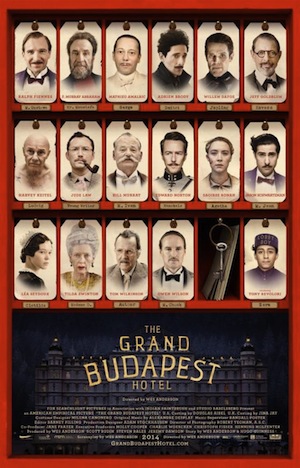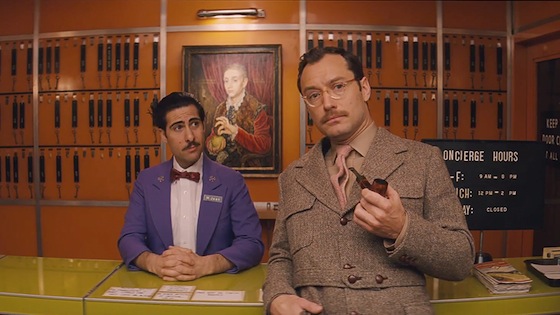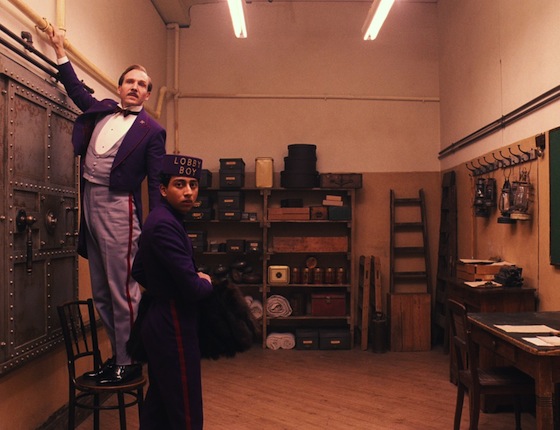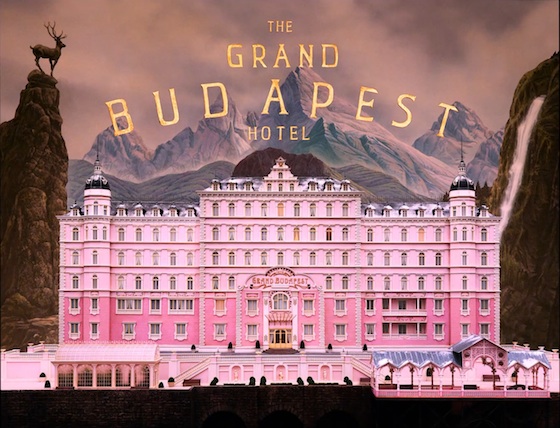 In The Grand Budapest Hotel director Wes Anderson seems to fully resolve two warring sides of his creative personality, the need to craft exciting visual moments and the ability to build a cohesive long form narrative. The Grand Budapest Hotel showcases some of Wes Anderson’s most expansive and meticulous visuals, while remaining a remarkably affective, character driven, caper film.
In The Grand Budapest Hotel director Wes Anderson seems to fully resolve two warring sides of his creative personality, the need to craft exciting visual moments and the ability to build a cohesive long form narrative. The Grand Budapest Hotel showcases some of Wes Anderson’s most expansive and meticulous visuals, while remaining a remarkably affective, character driven, caper film.
Set in the mythic Eastern European country of Zumbrowka, The Grand Budapest Hotel is a multi-bracketed story moving from contemporary time at the grave of a famous author, back twenty years to a documentary featuring an interview with that same author (Tom Wilkinson).
It is not until we get to layer three in the 1960s and four in the late 1930s that the core of our story takes off.
In the 60s, the author, here a younger man (Jude Law), meets Mr. Moustafa (F. Murray Abraham), the eccentric owner of the once glorious, now derelict Grand Budapest Hotel. Goaded by the author’s curiosity, Mr. Moustafa agrees to tell the story of the Grand Budapest over dinner.
 Mr. Moustafa tells of his coming to The Grand Budapest as a young refugee, Zero (Tony Revolori). His only wish is to become the junior lobby boy-in-training under the watchful guidance of M. Gustave (Ralph Fiennes), the meticulous concierge of the Grand Budapest.
Mr. Moustafa tells of his coming to The Grand Budapest as a young refugee, Zero (Tony Revolori). His only wish is to become the junior lobby boy-in-training under the watchful guidance of M. Gustave (Ralph Fiennes), the meticulous concierge of the Grand Budapest.
All of these layers could have made for a convoluted and complex plot, but Anderson shows an uncharacteristic amount of restraint when focusing on the multitudinous cast of characters. The calm narration from the older Mr. Moustafa, the single story elements that connect the various decades to one another, and the central plot involving M. Gustave, each serves to hold the magnificent story together.
In past films, in particular The Life Aquatic with Steve Zissou and The Darjeeling Limited, Anderson has allowed the glorious moment to puncture the cohesiveness of the larger narrative. The Darjeeling Limited felt more like a string of sometimes interesting moments, but the film lacked the requisite transitions necessary to create a coherent feature-length narrative.
 From The Royal Tenenbaums to The Darjeeling Limited, Wes Anderson was in his experimental phase, exploring the extent that he could push short visual digressions that add depth to his characters. By Darjeeling he was pushing these digressions so far that instead of a story, Anderson was offering his viewer a collection of cinematic digressions. He had discovered the limitations of his visual technique, and his experimental phase was about to come to a close.
From The Royal Tenenbaums to The Darjeeling Limited, Wes Anderson was in his experimental phase, exploring the extent that he could push short visual digressions that add depth to his characters. By Darjeeling he was pushing these digressions so far that instead of a story, Anderson was offering his viewer a collection of cinematic digressions. He had discovered the limitations of his visual technique, and his experimental phase was about to come to a close.
With Fantastic Mr. Fox, Anderson no longer treats his characters in an egalitarian fashion. Now he allows one or two to emerge as the central figures. The story arises from them and they drive its action.
The Grand Budapest Hotel offers Anderson’s most elegantly crafted narrative since Rushmore, while also employing Anderson’s years of fanatical visual development and control. The sets, props, costumes are all so vividly rendered and each folds into the multilayered stories so seamlessly that one must work to notice them all. It will take many viewings for these small details to fully emerge.
 Most exciting is Anderson’s newfound editorial strength. Now he is able to suppress the desire for a quick digression that develops a side character. By not distracting the viewer from the central narrative, Anderson allows his lush environment, full of fascinating characters, to exist in the background and showcase his two or three central characters.
Most exciting is Anderson’s newfound editorial strength. Now he is able to suppress the desire for a quick digression that develops a side character. By not distracting the viewer from the central narrative, Anderson allows his lush environment, full of fascinating characters, to exist in the background and showcase his two or three central characters.
It is a stunning accomplishment.
If you were a Wes Anderson fan before The Grand Budapest Hotel, then you should be very pleased with Anderson’s latest offering. If you have been on the fence in regards to Anderson’s storytelling, then The Grand Budapest Hotel may be the film you needed to come over to his way of thinking.







{ 2 comments }
I could not agree with this review more. You nailed it, Trey!
Thanks, Andee!
Comments on this entry are closed.